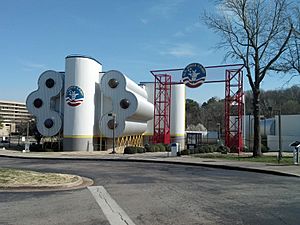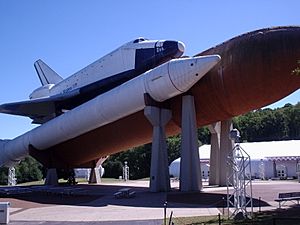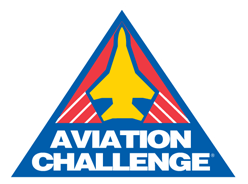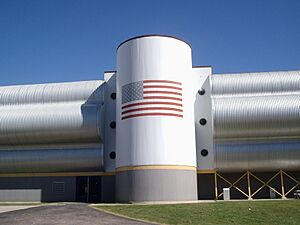Space Camp (United States) facts for kids
Quick facts for kids Space Camp |
|
|---|---|

Habitat One (left) and Habitat Two (right) at Space Camp. Habitats house campers staying for multiple days. Campers enter through the red gate.
|
|
| Location | Huntsville, Alabama, U.S. |
| Coordinates | 34°42′41″N 86°39′15″W / 34.71139°N 86.65417°W |
| Established | 1982 |
| Website | http://www.spacecamp.com/ |
Space Camp is an exciting educational camp located in Huntsville, Alabama. It's right next to the U.S. Space & Rocket Center museum and close to NASA's Marshall Space Flight Center. At Space Camp, kids and adults can join programs about space travel, flying, and robotics.
The camp is run by a state agency called the Alabama Space Science Exhibit Commission. Since it started in 1982, over 900,000 people have "graduated" from Space Camp. Some of these graduates even became real astronauts!
Contents
- Discovering Space Camp's History
- Exciting Programs at Space Camp
- Amazing Facilities at Space Camp
- Famous People Who Visited Space Camp
Discovering Space Camp's History
Space Camp began in 1982. Its main goal was to use the United States space program to make learning math and science fun for kids. The idea came from a famous rocket scientist named Wernher von Braun. In 1977, he was visiting the U.S. Space & Rocket Center. He saw kids studying rockets and asked the museum director, "Why don't we have a science camp, like we have band camps or football camps?" This question led to the creation of Space Camp!
How Space Camp is Managed
The U.S. Space & Rocket Center and Space Camp in Huntsville are managed by the Alabama Space Science Exhibit Commission. This is a state agency, and its members are chosen by the Governor of Alabama.
There's also a separate group called the U.S. Space & Rocket Center Foundation. This non-profit group helps raise money for scholarships. They also allow other countries to open their own Space Camps. You can find Space Camps in places like Space Camp Turkey, Space Camp Canada, and Space Camp Belgium.
Space Camp Locations That Closed
Over the years, Space Camp tried opening in other places.
Space Camp Florida
Space Camp Florida opened in 1988 in Titusville, Florida. It shared its buildings with the Astronaut Hall of Fame. This camp closed in 2002 because not enough people were attending, which caused money problems. About 50,000 kids went to this camp before it closed. Today, the Astronaut Hall of Fame is still open as part of the Kennedy Space Center Visitor Complex. Some of the simulators used by the camp are now available for all visitors.
Space Camp California
Space Camp California was located in Mountain View, California. It operated from 1996 to 2002. This camp also closed due to financial difficulties.
Honoring Space Camp Heroes: The Hall of Fame
The Space Camp Hall of Fame started in 2007. This was during the camp's 25th-anniversary celebration. The Hall of Fame honors people who have done amazing things in their careers after attending Space Camp. It also recognizes former employees and supporters who have helped the program a lot.
Some of the first people to be inducted in 2007 included:
- Dr. Wernher von Braun
- Ed Buckbee
- Dr. Georg von Tiesenhausen
- Dan Oates
- Dorothy Metcalf-Lindenburger
- Dr. James Rice
- Amanda Stubblefield
- Penny J. Pettigrew
Many other inspiring individuals have been added to the Hall of Fame since then.
Exciting Programs at Space Camp
Space Camp offers different programs for various ages and interests. Most campers visit during the summer. However, school groups, families, and adults also come in the spring and fall.
Space Camp for Younger Explorers
The main Space Camp program is for children aged 9 to 11. It lasts for six days. The activities are designed to be both fun and educational. Kids can choose from three different paths: space, aviation, or robotics. This was the first program offered, and its name is used for the whole organization.

Space Academy for Teens
Space Academy is a six-day program for ages 12–14. It's a step up from the younger Space Camp.
Advanced Space Academy
Advanced Space Academy is for older teens, aged 15 to 18. This program started in 1987. It even offered college credit through the University of Alabama Huntsville for a while!
Family Camp
The Family Camp program lets parents or guardians attend Space Camp with their child (ages 7–12). These programs run throughout the year and last three to four days. Adults and children work together on activities. There's also a Family Camp Aviation Challenge option in the summer.
Advanced Space Academy Elite
Advanced Space Academy Elite is for those who have already completed the Advanced Space Academy program. It offers special activities like scuba diving. In the past, there was also a longer, twelve-day Advanced Space Academy program. This included multiple missions and even used some of the Aviation Challenge facilities.
Scholarships for Campers
Space Camp wants everyone to have a chance to attend. They offer scholarships for children with disabilities, those with great academic talent, strong leadership skills, or families who need financial help.
Special Programs for Diverse Learners
Space Camp works hard to make its programs available to all students.
SCI-VIS: Space Camp for Visually Impaired Students
Space Camp has a special week-long program for visually impaired students. It gives them the same amazing experience as sighted students. Computers are adapted to provide speech and large print. Materials like handbooks are available in Braille.
Deaf Space Camp
There's also a week-long program for deaf and hard of hearing students. American Sign Language interpreters help with communication. Most movies have captions. Students use live video streams between mission control and the shuttle simulator instead of headsets. Students in this program often meet deaf adults who work in science. They learn about contributions from deaf individuals like Annie Jump Cannon (an astronomer) and Tsiolkovsky (a "father of Rocketry").
Other Unique Programs
Space Camp also offers programs for adults, teachers, and school groups. There's even an X-Camp for outdoor leadership. Sometimes, special themed camps are offered. For example, a Jedi Experience camp was held when the museum had a Star Wars: Where Science Meets Imagination exhibit. In 2017, U.S. Cyber Camp was announced, focusing on Cyber Security.
Aviation Challenge: Become a Fighter Pilot
Aviation Challenge (AC) is a group of camps focused on flying. It has three main programs for kids aged 9–18. In Aviation Challenge, campers use computer-based flight simulators. The goal is to teach them to fly, act, and think like United States Air Force, Navy, or Marine fighter pilots.
Amazing Facilities at Space Camp
Space Camp has incredible facilities to make your experience feel real.
Simulators for Space Travel
You'll get to try out several cool simulators:
- The MAT (Multi-axis trainer) spins you around. It helps you understand what it feels like to get disoriented in space.
- The 1/6 Chair makes you feel like you're walking on the Moon.
- The 5DF Chair lets you experience the frictionless environment of space. It moves in five different directions.
- The MMU (Manned Maneuvering Unit) simulates working freely in space, like during a spacewalk (EVA).
Space Camp also uses rides at the U.S. Space and Rocket Center to teach you about space travel. The Space Shot simulates the feeling of a rocket liftoff. The G-Force Accelerator shows you the intense G-force astronauts feel during launch or when re-entering Earth's atmosphere.
The Intuitive Planetarium is a modern theater where you can watch shows about space and science. It replaced the old Spacedome IMAX theater in 2019.
Where Campers Stay
If your Space Camp program lasts more than one day, you'll stay in Habitat 1 or Habitat 2. Habitat 1 is a large building designed for young people. Staff members are always there, and there are security cameras. Boys and girls usually stay on separate floors.
Aviation Challenge trainees stay in Habitat 3. They are expected to keep their rooms very neat, like in the military. There are two floors in Habitat 3. Boys stay on half of the ground floor and all of the second floor. Girls stay on the other half of the first floor. The rooms are named after famous aircraft carriers. All campers eat their meals in the camp's cafeteria.
Famous People Who Visited Space Camp
Notable Attendees
Many interesting people have attended Space Camp, including future astronauts and children of famous figures:
- Astronauts and cosmonauts:
- Samantha Cristoforetti attended in 1995 when she was 18.
- Robert Hines was 14 when he attended in 1989.
- Sandra Magnus attended an Adult Space Academy weekend in 1991.
- Dorothy Metcalf-Lindenburger attended at age 14.
- Jasmin Moghbeli attended Advanced Space Academy in 1998 at age 15.
- Beth Moses attended Adult Space Academy in 1989.
- Kathleen Rubins dreamed of being an astronaut and earned her trip to Space Camp in seventh grade.
- Alyssa Carson, a space enthusiast, has attended all Space Camp programs.
- Chelsea Clinton, daughter of then-President Bill Clinton, attended in 1993.
- Karenna Gore, daughter of then-Senator Al Gore, attended in 1985.
- Amy Carter, daughter of former President Jimmy Carter.
- Actors Mary-Kate and Ashley Olsen attended while filming The Adventures of Mary-Kate & Ashley.
- Jacob Roloff, from the TV show Little People, Big World, attended in 2009.
- Musician Bruce Springsteen's children have attended several programs.
- Actor Austin O'Brien attended in 1997.
Special Guests
- The cast and crew of the movie Apollo 13 visited Space Camp before making the film. Tom Hanks, who played James Lovell in the movie, returned in 2006 when his son was attending. He even had breakfast with some German rocket scientists!



